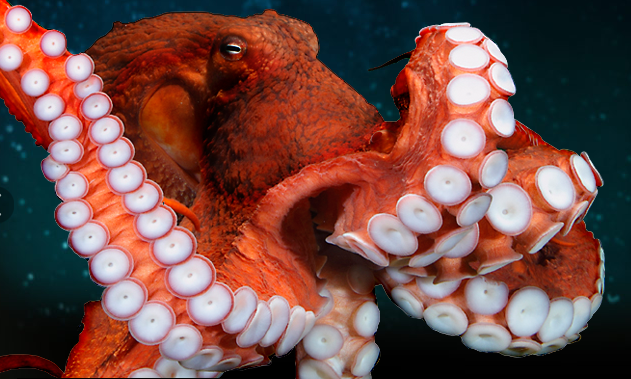GIANT PACIFIC OCTOPUS
By Matias Totz
Background Info
At the aquarium I volunteer at, one of the biggest tourist attractions is our Giant Pacific Octopus! I have been fascinated by these creatures for so long and now I get to see one every week. I took some time to research these magnificent creatures. Apparently, the giant pacific octopus is the biggest species of octopus in the world and they live in the North Pacific ocean, in the intertidal zone about 6,600 feet below sea level! These little guys are not so little and can have an arm span of about 14 feet and can weigh about 30 pounds! I also learned that you can’t call an octopus’s arm a tentacle because it is actually an arm. They have a total of eight arms and have a beak in the center of their arms that contains a radula. A radula is toothed tongue and it is quite commonly seen in marine animals. Probably the coolest thing I learned about the octopus is that it has its stomach in its head! The mantle contains most of the major organs including the stomach, the hearts, the brain, and anus! Sadly my aquarium can only keep one octopus for about eight months at a time because these animals only can live up to 3-5 years old.
Diet
I always wondered what an octopus’ diet looked like, so I looked it up. Octopus eat shrimp, crabs, abalone, scallop, clams, lobster and fish. The octopus captures its prey by using its tentacles which are lined with suckers, and then bites into its prey with its beak. Some shark species have also been found inside this octopus! Maybe that’s where my missing dog went…
At the aquarium I volunteer at, one of the biggest tourist attractions is our Giant Pacific Octopus! I have been fascinated by these creatures for so long and now I get to see one every week. I took some time to research these magnificent creatures. Apparently, the giant pacific octopus is the biggest species of octopus in the world and they live in the North Pacific ocean, in the intertidal zone about 6,600 feet below sea level! These little guys are not so little and can have an arm span of about 14 feet and can weigh about 30 pounds! I also learned that you can’t call an octopus’s arm a tentacle because it is actually an arm. They have a total of eight arms and have a beak in the center of their arms that contains a radula. A radula is toothed tongue and it is quite commonly seen in marine animals. Probably the coolest thing I learned about the octopus is that it has its stomach in its head! The mantle contains most of the major organs including the stomach, the hearts, the brain, and anus! Sadly my aquarium can only keep one octopus for about eight months at a time because these animals only can live up to 3-5 years old.
Diet
I always wondered what an octopus’ diet looked like, so I looked it up. Octopus eat shrimp, crabs, abalone, scallop, clams, lobster and fish. The octopus captures its prey by using its tentacles which are lined with suckers, and then bites into its prey with its beak. Some shark species have also been found inside this octopus! Maybe that’s where my missing dog went…
Fun Facts
I learned a ton of things from these creatures and maybe you can learn a few things about them too! They have blue blood to survive in the deep ocean. The blood contains a copper called hemocyanin, which makes their blood blue. The copper is more efficient at transporting oxygen when water temperature is very low and not as much oxygen is around. This octopus also has three hearts. Two of which are branchial hearts which each pump blood to one of the gills. The third heart pumps blood through the whole body. I don’t think these guys need to worry about getting a heart attack! This octopus can fit through small holes because they have no bones. A 600-pound octopus can squeeze through a quarter-sized tube! Do I even need my bones? I think the first super human should have rubber bones so they can squeeze through small cracks and holes too!
I learned a ton of things from these creatures and maybe you can learn a few things about them too! They have blue blood to survive in the deep ocean. The blood contains a copper called hemocyanin, which makes their blood blue. The copper is more efficient at transporting oxygen when water temperature is very low and not as much oxygen is around. This octopus also has three hearts. Two of which are branchial hearts which each pump blood to one of the gills. The third heart pumps blood through the whole body. I don’t think these guys need to worry about getting a heart attack! This octopus can fit through small holes because they have no bones. A 600-pound octopus can squeeze through a quarter-sized tube! Do I even need my bones? I think the first super human should have rubber bones so they can squeeze through small cracks and holes too!
No comments:
Post a Comment